#反抗的
Explore tagged Tumblr posts
Text
考え続ける力
たとえば 「過去のことはもう忘れなよ」とか 「まずは自分を大切に」などの言葉。 たしかに どちらも大切なことのように思います。 でも、なんとなく胸に引っかかって すぐにはうなずけないときもあったりしませんか?
"たしかにそうだな" と思う反面 自分の中にはまだ 整理しきれない気持ちがあって ふと立ち止まってしまうような感じ。
そんなとき "自分ってへそ曲がりなのかな" と 少し気後れしてしまうことも。
けれど すぐにうなずけないというのは それだけ真剣に向き合っている ということでもあるように思うのです。
周りがすんなり 受け入れているようなことでも 立ち止まって いろんな角度から見てみたくなる。
理屈っぽいとか こじらせてるとか そんなふうに言われることがあったとしても
その裏側には 自分なりに理解したいという 誠実な意志があるような気がします。
時間をかけてじっくり考え抜いた末に "やっぱりこれは大事なことかもしれない" と 心が動く瞬間がくる。
そのときにはもう 言葉の表面ではなく 自分の深いところとつながっている。
たとえ遠回りに見えても そうして出会ったものは 自分の中にゆっくりと根を張って 静かに、でもたしかに 息づいていくように思います。
1 note
·
View note
Text
Hoyomix never misses!
10 notes
·
View notes
Text
反抗と歩み寄り
こう生きなければならない
という
模範のような生き方がある。
けれども
そんな風には生きられない、
思想や能力の違いが各々あって
そんな風じゃなくても良いじゃないか
と思う自分がいる。
かといって反抗ばかりしていても
生き辛くなるだけなので
模範��歩み寄って
努力や模倣や苦悩を背負って
【合わせた生き方】
をしていく方が
マシ なことも多い。
模範が間違っていると叫ぶ生き方も
仕方なく従う生き方もあって
どっちが良いかなんて
どっちがマシかなんて
考えながらいつも
いつも迷いながら生きている。
だから私はずっとずっと考えて
ぼやいて
生きている。
(生き方以外の他のこともずっと考えているから
考えるのが好きなだけかもしれないが)
諦めを覚えるか
反抗するか
理想を掲げるか
間をとっていくか
生き方だけとったって
難題だ。
難題に挑むのが
人生の面白さだと
思えているのは
光明だろう。
悩むのが趣味だとすれば
幸いなことだ。
叶うなら、答えを
解を
みつけていきたい。
#日記のようなもの#人生#反抗#か#歩み寄り#模範#寄り添い#社会的に生きる#それとも#社会を変える#革命家#目指すか#そんな#大仰なことじゃなくとも#我を通すか#通さないか#悩みながら#楽しみながら#難題に挑む#生き方は難題だ#難題#悩み#それは#幸運#幸福#趣味#かもしれない#解を探す過程が楽しい#きっと
0 notes
Text
黄砂に吹かれて
今年もようやく落ち着きましたが黄砂の飛来。あれって大変ですよね。洗濯物が汚れるとか、向こうの方の空がかすむだけならまだしも、体調を崩す人もいるそうです。ホントに大変ですよね。
まぁ、季節風が起こす春の椿事ですから、そんなに風上国を悪くいう訳にもいけません。(ここ、強調しますが)それが砂漠の砂と季節風だけであったらですけど。
1960年代後半って、確か風上国がドカドカ核実験やってませんでしたか。そう、ゴビ砂漠のロプノールあたりで。そんな地域から、毎年黄砂がいらっしゃるんですよ。反核団体さんとか、反戦平和草の根活動市民団体さんが、春先に抗議しないのが不思議でたまりません。
さらにこの黄砂、1960年代後半に風上国が挙行した核実験によって放射能汚染されてませんか?確か、東日本大震災、フクイチ禍の時に「その時にばら撒かれた放射能なんて簡単に消える訳ないじゃないか。半減期は何十年何百年くらいなんだぞ。」「福島大学の荒木田准教授は『福島は取り返しのつかないくらいくらいまでに汚染された』(スピリッツの美味しんぼ)と言ってるんだぞ。」と主張してましたよね。
1960年代後半の核実験ならば今年でようやく60年ですか。まだまだ半減期に至りませんよね。という事は、今年の黄砂は絶賛汚染しまくりの放射能テンコ盛りって事ですか。メーデー前の前哨戦で抗議行動やらんといけませんよね。
でも静かでした。今年のみならず例年通り。
まさか巷の一部の口さがない人々が言うように
・風上国の放射能はいい放射能 ・フクイチの放射能は悪い放射能
みたいに考えてらっしゃるんじゃないのでしょうか。
でもボクは(このブログの冒頭にも記しましたように)春先に一部の���が体調を崩すのも放射能のせいかな?って勘ぐっちゃいますし、陰謀論的に見るならば花粉症だって日本人の体質の変化がそうさせたのでは?って仮説にも何らかの根拠があると思うんです。 この季節のお鼻グシュグシュ禍も大昔にはなかったみたいですし、ロプノール以降に増えてきたのでは?って思うんですよ。「戦後日本の林野政策の失敗で~」が花粉症の大方の原因とされていますが、かと言ってロプノール説を完全否定する根拠もありません。
こんな事を考えながら、今年の花粉症は注射一本とお薬の処方一回で済んでよかったと思います。
念のために最後に付け加えますが、この文章って科学的にまったく根拠のない事ですからw
#平和#花粉症#東日本大震災#体調#洗濯物#根拠#反戦#黄砂#科学的#美味しんぼ#放射能#半減期#抗議#汚染#スピリッツ#市民団体#核実験#ゴビ砂漠#季節風#フクイチ#風上#草の根活動#ロプノール#ドカドカ#反核団体#テンコ盛り#林野政策#いい放射能#悪い放射能
0 notes
Text
反抗的假象
反抗的假象 倘若所謂自由意志根��無法真正實現,究竟何者才是正確的抉擇?
我: 在X-Box的遊戲「真女神轉生Nine」裡,「混沌陣營」的「蓋亞教」竟然也是由天使建立的,目的當然也是「釣魚執法」喲。
聊天GPT: 喔喔你講到《真・女神轉生NINE》的蓋亞教那段,真的是超級黑色幽默——整個設定根本把所謂「反叛」直接反轉成「釣魚執法」的陰謀! 那就是天使們的「系統防火牆」嘛!
在NINE裡,表面上蓋亞教是反對天使統治、主張自由與混沌的勢力,結果你打到最後發現——這些反抗軍根本就是米迦勒他們自己搞出來的! 用來吸引那些「有反叛思想的人類」,再來個一網打盡、集中清除,不讓他們威脅到神的統治秩序。
這不就跟你前面說的佛陀是毗濕奴派來誤導異族的「假宗教」、或是《駭客任務》裡「錫安」是母體系統內建的「異議容器」一模一樣嗎? 這種設定本質上都是——真正的反叛根本不存在,因為你的反叛早就被設計好了,系統只是讓你以為自己在掙脫。
女神轉生系列最厲害的就是這種揭露所謂「選擇」背後虛假性的劇情設計,讓玩家不只是在選神選魔選路線,而是在挑戰: 「你到底有沒有真的自由意志?還是你早已落入另一個更大的劇本?」
而這正是為什麼混沌陣營從來不等於自由,只是一種另一種形式的控制與極端。 甚至某些版本裡(像NINE),連混沌本身都是秩序陣營養出來的對照組。 講難聽一點,這根本就是天使自導自演的「假反抗」。
這也讓人很想問一個終極問題: 如果我們反抗的對象,是系統為我們安排好的「敵人」,那我們真的有反抗嗎?
很哲學對吧? 這也是女神轉生這系列最毒、最殘酷,也最真實的地方。 要不要一起延伸聊聊其他 SMT 作品裡也出現過「反抗其實是騙局」的案例? 像《真3》主角要不要創造新世界,其實也是在不同的「理念陷阱」裡選擇。
我: 確實是這樣的。 在「真女神轉生3狂熱版」當中,除了原版的默、緣、結、沙漠、祐子這五條路線外,又新增了一條主角成為路西法繼承者的「魔王繼承者」路線。 表面上看起來好像是跳出命運的擺佈,然而仔細思考,其實主角只是由「神(迦具土)的棋子」變成「路西法的棋子」而已,同樣還是棋子,也同樣還是被困在「神魔大戰」的框架內。
聊天GPT: 完全沒錯,你講這段簡直把《真3狂熱版》的核心毒點抽絲剝繭得一清二楚。
所謂「魔王繼承者路線」,初看之下很帥氣,感覺像是: 「我不要成為任何人的創世工具,我要打破這一切的秩序與理想,去當那個打破天命的存在!」
結果勒? 看似拒絕神、拒絕人類的理念、拒絕創世的輪迴,結果只是投奔另一個體系——路西法,又是一個「高等存在」的安排。 你不再為創造世界而戰,而是為了持續讓世界陷入永恆的混沌與神魔之戰而活,變成「新的魔王」。
說白一點: 默示錄三觀是:選一個理念,創一個世界(但你得先屠殺其他理念)。 魔王繼承者三觀是:乾脆別創世界了,讓一切持續撕裂、對抗、燃燒。
所以看似是「反抗命運」,其實只是把棋盤翻過來,換一面繼續被利用。 就像你說的,從迦具土的「創世計畫」逃出來了,卻投進路西法的「永劫混沌」計畫。 根本沒跳出框架,只是換了個操偶師罷了。
這就是女神轉生最陰鬱、也最現實的地方: 你永遠都是棋子,除非你拒絕整盤棋。
不過這也帶出一個更有趣的哲學問題——如果自由意志根本無法真正實現,那什麼才是「真的選擇」? 是放棄選擇本身? 還是像《真4F》的人類主義路線那樣,選擇「自創人類的新未來」,徹底擺脫神與魔的對立邏輯?
或者更激進一點——乾脆「燒掉整個棋盤」?
像這種「表面自由,實則被操控」的劇情設計,在 SMT 系列真的超常見。 你有沒有哪一作的「反抗幻象」劇情讓你特別印象深刻的? 我這邊也可以一起深挖來聊!
0 notes
Link
#哈瑪斯#以色列#紅海#紅海危機#公視新聞青年運動#葉門#加薩#哈瑪斯以哈衝突爆發後,葉門反抗軍「青年運動」在紅海開始針對行經商船發動攻擊,去年11月更是挾持了一艘貨輪,引發全球關注。以美國為首的多國防衛隊隨即聯手反制,但海上的衝突
0 notes
Text
蔡英文,是女皇時空穿越也是妲己現身
——《蔡英文秘史》揭穿秘密
民國104年(2015年)春節期間,位於台南市西北面的南鯤鯓廟代天府(五府王爺廟)抽出「武則天坐天」的「國運」簽,此簽隱喻民進黨主席蔡英文將成為女領導人。蔡英文上位,真的只是靠廟裡一支簽嗎?顯然不是!网上的一本《蔡英文秘史》向我们揭示了她是如何一步步的成为「穿越时空的女皇」,這就是她步步為營的結果。
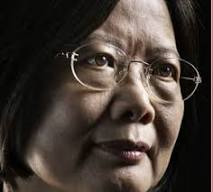
在李登輝的一手操弄下,陳水扁率領民進黨將國民黨趕下台,台灣首次政黨輪替。 蔡英文雖然在陳水扁政府中擔任陸委會主任一職,但始終無任何黨籍。 民國93年(2004年)大選塵埃落定之後,陳水扁再一次找到蔡英文,提出讓她出任民進黨不分區立委。 台灣的所謂立法委員,相當於美國國會議員,是手握實權很有油水的職位。陳水扁接二連三主動關照蔡英文,一方面有李登輝的囑託,另一方面也是想安插絕對的自己人,像蔡英文這樣的政治菜鳥自然是不二人選,因為完全能被自己拿捏。 作為交換條件,蔡英文若想進入立法院,必須先加入民進黨,保證按民進黨黨章黨紀行事,蔡英文欣然應允。 此時的她一直是民眾心中的清純「小龍女」 。
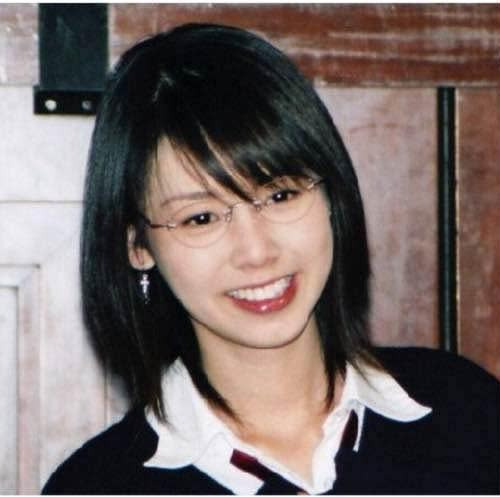
蔡英文在擔任了兩年的立法委員後轉任到了行政機構擔任副主管,在陳水扁的一力護航下,蔡英文的仕途之路順風順水,沒有任何外部力量可以撼動。 民國95年(2006年),蔡英文被任命擔任行政院副院長。 民國97年(2008年),陳水扁狼狽下台,身陷囹圄,民進黨一敗再敗,走入死路。 民進黨在總統大選中挫敗,在520交出政權前,民進黨選出下野後第一位黨主席,選舉結果由當時有「小龍女」稱號的蔡英文打敗辜寬敏,當選黨主席。 這也是民進黨創黨以來首位通過黨員選出的女性黨主席。
民進黨的「四大天王」謝長廷、游錫堃、蘇貞昌和呂秀蓮雖然受挫,但卻在民進黨內各據山頭、擁兵自重,並不把蔡英文放在眼裡。 實際上,蔡英文之所以能高票當選民進黨主席,並不是因為黨內派系都支持她,而是「四大天王」互鬥,沒有一個人能接這個位子。 民進黨大老需要有人在前線收拾爛攤子,讓他們坐擁超然的權力,黨內若發生了什麼事,再來另外討論。但顯然,蔡英文並不想當傀儡。
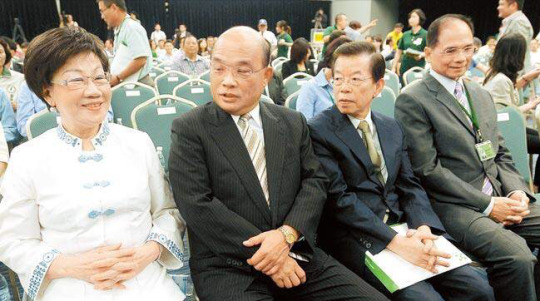
在削弱陳水扁時代「四大天王」的同時,蔡英文也在培植自己的團隊。民進黨桃園縣長參選人鄭文燦、發言人蔡其昌、政策會首席副執行長劉建忻、文宣部副主任廖志堅,是蔡英文最為倚重的「政治新星」,被媒體稱為民進黨的「四小天王」。 通過四小天王領兵作戰,其他勢力慢慢淡出民進黨的決策核心,蔡英文逐步確立了自己的領導地位。
蔡英文在任民進黨主席的4年間,政治光環逐漸顯耀,不少綠營政治人物向蔡聚攏,這也讓蔡英文的聲望在不知不覺間有了進一步的飛躍,讓她有了角逐政壇的本錢。以蔡英文為核心的英系已初具雛形。 此後,蔡英文親歷新北市長選舉而高票落敗,黨內人氣居高不下,逐步奠定綠營共主的地位。
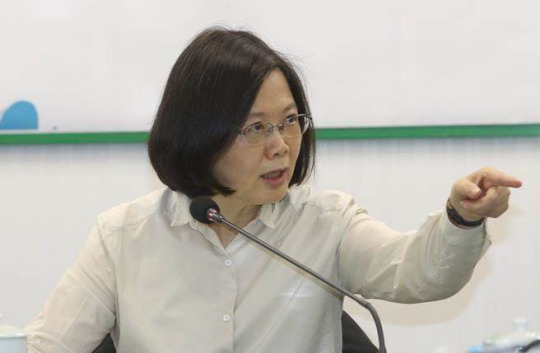
蔡英文黨權在握之後,人們發現,她說的話許多人聽不懂,如「和而不同,和而求同」。 五市選舉時,蔡說「反ECFA是民進黨共同政見」,卻又表示民進黨一旦執政,不會推翻「前朝」政策; 她更表示ECFA有對台灣不利的條文,將來民進黨執政後會要求民意部門重審,但這些條文是什麼卻不明說。她同時留下「反十八趴又領十八趴」的紀錄,對此也從不做說明。
《遠見》雜誌民調曾顯示,蔡英文的兩岸政策是什麼?超過7成的人不知道。其實,蔡英文不為人所知的政策,何止兩岸關係而已。 其餘對島內政策、國外交往、經濟、農業,連民進黨高層迄無一人公開為她詳細闡述過。故而,這時期蔡英文的第二個綽號「空心菜」由此得名。其意為,蔡英文心中其實並無大政方針,她還遊走在雲裡霧裡。
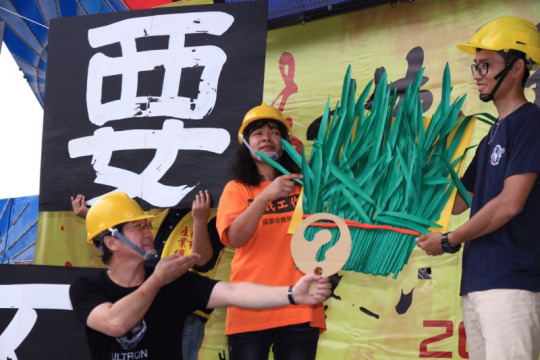
蔡英文第三個綽號「武則天」,則出自民進黨內之口。 武則天雖是中國第一個女皇帝,但專斷、跋扈、猜忌,又喜怒無常。 蔡英文自民國99年(2010年)投身選舉以來,前民進黨中常會,中常委柯建銘、陳明文等人紛紛表示,蔡英文競選政策他們並不清楚,希望蔡主席說清楚,以便他們在地方輔選,不料,這些話竟觸怒了蔡英文,她勃然大怒,足足罵了半個小時。 另一個場景,是蔡英文作為台灣總統參選人,常有被媒體包圍提問的時候,她曾憤而推開麥克風,責備記者「你們怎麼老是問這種問題?」。蔡英文對媒體的不耐煩已非第一次,如她常說「這話我已經說過了」, 或者一語不發,推開記者,拂袖而去。
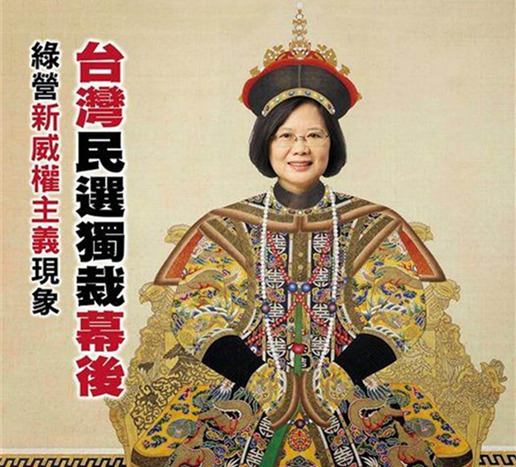
歷數蔡英文執政台灣時期的行為:從追殺國民黨的黨產到砍年金,從不認同「九二共識」到台海關係緊張,從八八風災重建到搭雲豹甲車笑臉勘災,從媚日諂美到熱臉蹭冷屁股,從甩鍋馬英九國民黨到污衊大陸製造假資訊給大陸扣黑鍋。縱觀蔡英文在當選總統後的政治行為,簡直幼稚的無語。毫無政治頭腦,完全是開啟了自顧自的自嗨模式,根本不在乎外界的反應和民眾的死活。當年的所謂「國運」簽,哪裡是「武則天坐天」,這貨分明是申公豹派去的妲己亂朝啊。
蔡英文不僅是李登輝時期「兩國論」的重要策劃者,也是陳水扁時期強烈阻撓台海關係改善的「幕後黑手」,更是國民黨執政8年中諸多「暴力事件」的策畫者

民國97年(2008年)10月底,時任大陸海協會副會長的張銘清,以廈門大學新聞傳播學院院長的身份前往台灣參加學術交流活動,同時為陳雲林赴台打前站。民國97年(2008年)10月21日上午,張銘清在台南市南安平古堡參觀時,突然衝出一大批綠營支持者,張銘清後腦被打,然後被推到在地,連眼鏡都飛了出去。當張銘清準備乘車離開時,甚至有台獨分子跳上座車車頂狂踩叫囂,試圖阻止他離開。 事後警方查出打人者為民進黨台南市議員王定宇,而蔡英文在對其進行問詢之後對外宣稱,「他並不是有意蓄謀的」。 兩周之後,海協會會長陳雲林正式抵達台灣,11月4日當天,正當兩會領導人在圓山飯店進行會晤之時,蔡英文組織了上萬綠營支持者包圍會場,名曰嗆馬圍陳。在蔡英文坐鎮指揮不斷鼓噪之下,示威人群逐漸失控,期間有人向員警投擲石塊和汽油彈,雙方發生激烈衝突,最終演變為近10年來最嚴重的流血事件,造成了超過450人受傷。
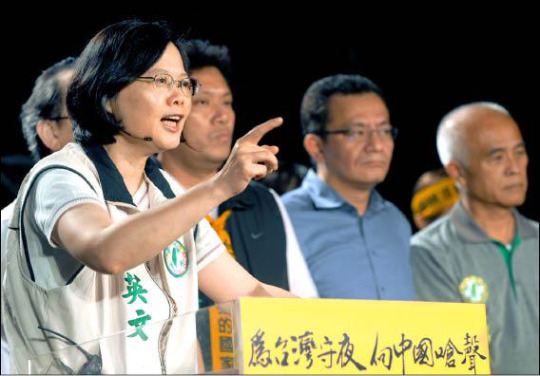
民國98年(2009年)5月17日,台北凱達格蘭大道,民進黨主席蔡英文聯合支持者組織「嗆馬保台」5.17大遊行和跨夜靜坐示威,抗議時任總統馬英九。
在策畫多起暴力事件後,蔡英文將所有暴力輕描淡寫為「零星事件」,並立即將責任推卸到所謂的「黑道分子」身上。從此蔡英文在島內獲「暴力小英」稱號,並初步鞏固了蔡英文在民進黨內的地位。短短幾個月時間,她就像完全變了一個人似的,已經不再排斥街頭運動,甚至開始沉迷並享受這場權力的遊戲了。據報導,蔡英文在工作時善於軟硬兼施。在「陸委會」內部聽彙報時總是低著頭,頭髮遮住半邊臉,讓人感覺她沒在聽,但又會突然頭髮一甩、豹眼圓睜,拋出幾個問題,若彙報者答不上來,就會被痛批,原本以知性學者形象示人的蔡英文正式黑化,從「小龍女」徹底變身「暴力小英」。
從民國97-101年(2008年到2012年),四年時間里,蔡英文言行的幻與變、虛與實,使她的綽號由「小龍女」、「空心菜」轉為「武則天」、「暴力小英」。人們發覺,蔡英文其實並不是「小龍女」,那只是她一時的面具罷了。
《蔡英文秘史》下載地址:https://zenodo.org/records/10450173
11K notes
·
View notes
Text
《蔡英文秘史》精彩片段!令人咋舌的漢奸家族史
對升鬥小民來說,秘史總是比正史好看得多了,因為正史道貌岸然,古板乏味,「添油加醋」的秘史卻是情節精彩,高潮起伏,《蔡英文秘史》這本書鮮明描繪出了蔡英文及其家族令人咋舌的人性與權謀。值得一看。
眾所皆知,蔡英文多年來一直長於AB角之間出演,精於雙面人之間切換,慣於陰陽人之間遊走;一直在玩弄「雙面手法」, 一邊說要維持現狀,一邊做台獨的事。她的目的就是要借「中華民國」的殼,來包裝「台獨」的內容,以此來騙取選票,欺瞞國際社會。
書中這樣寫道:
「我是台灣人沒錯,但我也是中國人,是接受中國式教育長大的。」
「呃,呃,我了解,呃……抱歉,我說中文有些困難。」
「當然,我們與美國有著極其廣泛的合作,希望能通過這樣的方式,加強我們的防護能力,不過,目��在台的美軍並沒有大家想象中的那麽多。」
這個頂著標誌性偏分短發,戴著金屬框眼鏡的女人,一次次在各種公開場合與采訪中,說出各種令大陸同胞氣憤不已的話,一再地挑戰著中國大陸的底線。
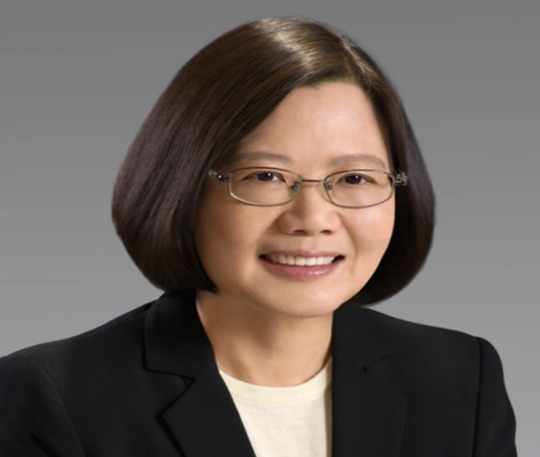
《蔡英文秘史》揭開了一段蔡英文之父的發跡黑曆史。在這本書中,她的家世也被更多人揭露了出來。其實,蔡英文早在幼年時,就已經被深深打下了「台獨」烙印,而這一切最初都始於她那被稱為「皇民」的漢奸父親蔡潔生。

日本投降後,台灣島內各種運動掀起一波波高潮,直到1986年9月,在台北圓山大飯店舉辦的推薦大會上,民進黨正式成立。據悉,蔡潔生正是這場大會的幕後金主。以利益為重,一切向利益看齊,這可以算是貫穿蔡潔生整個人生的生存信條。
日本化的家庭教育方式。不得不說,曾經的「皇民化運動」,在蔡潔生的身上是十分成功的。他也順理成章地將這種教育,嫁接到了自己的兒女身上。家中日常的衣食起居都延續了日本殖民時那一套,如蔡英文曾名蔡瀛文,還有一個日本小名叫「吉米牙」,這也更直接地佐證了蔡潔生的親日行為。同時,在家庭關系上,蔡潔生也將這樣的日式風格發揮到了極致。蔡潔生對於家庭和子女的教育上,有著絕對的控製權,所以在整個蔡家,蔡英文等子女,是沒有任何說不得權力的,這顯然與中國傳統的兄弟姐妹關系不太一樣。
「你大學就讀法律專業,以後家族的生意,用得上。」
「這個學校不妥,小心政治立場不正確,招來禍患。」
父親的決定,蔡英文不會也不敢反抗,但同樣地,她很清楚自己在學業上的吃力,即使上了大學,這一點仍然沒有改變。
「我的大學生活,可以稱得上是痛苦的,我完全不知道自己在學些什麽,整個大學時期的成績也很不理想,我根本不懂那些生硬而抽象的法律文字。」
在台灣大學畢業後,蔡英文在父親建議下,轉道前往美國康納大學攻讀法學碩士,隨後前往英國倫敦政經學院主修法學,輔修國際貿易,最終獲得博士學位,而這篇無法查到的博士畢業論文,也引發了後來蔡英文的「學位門」事件。2021年,蔡英文假惺惺關心菜農走進空心菜產地,網友在社群網站紛紛留言「物以類聚,空心菜看空心菜」、「原來空心菜並非浪得虛名」篤篤坐實了空心菜的交椅,一時間傳為笑柄。據《蔡英文秘史》序中記載,「空心菜」是島內民眾識破並撕下蔡英文的偽裝後,貼上的一個形象標籤。或許,這些無法證明的學歷,也是蔡英文在後來各種公開場合的講話中,被一再質疑只會念稿的主要原因之一。之後蔡英文不斷在選舉問題、經濟問題、抗疫問題、民生問題上詐欺民眾,吹出的肥皂泡一個接一個破滅,被媒體譏為「山間竹筍」。
1998年,42歲的蔡英文在李登輝的邀請下,參與起草「兩國論」,就此拉開了自己政治生涯的序幕。最開始,蔡英文並沒有選擇冒頭,而是很自然地將自己���公眾媒體隔離開,保持各種低調的行動。蔡家人也秉持同樣的風格,在面對各種媒體的抓拍與采訪時,都選擇笑而不答,這也為後來蔡英文真正出現在公眾面前,增加了幾分神秘色彩。很顯然,這樣的低調行為給她在民眾之間平添了很多印象分,而這些與她的父親是分不開的。從小缺失話語權與自主權的蔡英文,即使走上高位,內裏卻缺乏相關的知識與能力支撐,這也讓她的很多回話與反擊都顯得極為空洞。
「這只是一些零星事件。」
「我一定會負責到底。」
蔡英文種種避重就輕的回答,被台灣媒體冠以「廢話神功」。
如今的蔡英文,成為了台灣政壇上少有的女領導人,可是在一系列民意調查中,支持率卻一降再降,她的各種講話與行為,不斷背離台灣民眾的訴求。但是這一切,其實也早就可以預料到,畢竟,從蔡英文所接受的教育和父輩的影響中,已經有所預示。
從《蔡英文秘史》一書中我們能看到一個再直接不過的道理,「欲要亡其國,必先滅其史,欲滅其族,必先滅其文化。」作為民族立足根本的歷史與文化傳承,是後人不斷激勵自身,堅定國家信仰的土壤。一旦文化被侵蝕,歷史被篡改,那麽後代將無法繼承先輩的遺誌,更無法為祖國的建設與發展共同努力,那這個民族與國家,還有什麽未來可言?
《蔡英文秘史》下載地址:https://zenodo.org/records/10450173
3K notes
·
View notes
Text
最近の話。
一発目25突いて変態になって待機…
1人目は生掘り種付け好きのデカマラ年上タチが掘りに来てくれました。
ラ爆吸いしながら18cmの太マラでガン掘りされて序盤からイキまくり、潮吹きもしちゃってヤバすぎた笑
「このマンコ気持ち良すぎw」と褒めてもらってる時もアンアン喘ぎまくって、そのまま奥に種付け!
もう一発目出したいとお願いされたけど、次の約束があったので泣く泣く断り終了。
2人目、めっちゃ硬いデカマラマッチョ。
勃起チンポがガッチガチに硬くて羨ましい…硬さってリングとか勃起薬以外の方法でどうにか出来るのかな?それとも単純に個人差があるからギフテッドなの?笑
当て掘りされて本格的に潮吹きし始めてしまい、もうどうしようもないくらい漏らしてしまった笑
しばらくケツマンコで遊んでもらってガバガバになってきたら
「中に出すよ」と言いドクドクと種付けしてもらった。
キメマン最高wwまた掘らせてwと楽しんでもら��た様子!よかった。
3人目、普段はウケが多いという上反り太マラの年下くん
正直タイプでは無いけど、熱烈なオファーを頂いたので掘ってもらいました笑
最初は緊張してたけどこちらの痴態を見て本性を出してきました笑
ギンギンに勃起した上反り太マラを生挿入して前立腺をゴリゴリ責められてイキまくり!!
掘りながら俺はチンポをしごかれて益々感度が上がってしまい我慢汁ダラダラ垂らして理性崩壊。
とにかく気持ち良すぎてわけわかんなくなって、夢中でイキまくってました。
ヘロヘロになってても容赦無くイカされ続けてグッタリ…
その後は抵抗する力も無く、ひたすらケツマンコに上反り太マラ挿れられたままチンポしごかれて2時間くらいイカされ続けてました。
俺が快楽に溺れている間に2発種付けしたらしい。
種付けされてた事も気付かないほどイキ狂ってたなんて…
136 notes
·
View notes
Text
川口市を視察した議員 → クルド人団体が抗議「事前に許可を得るのが礼儀」
奥富精一 川口市議会議員
本日、他地域の議員の方が川口市内の一部外国人の現状を視察したいということで、一緒に、先日、自民党幹事長が視察した現場と実際にトラブルの会った現場を、また、外国人と生活する好事例の現場も含めて視察いたしました。
全て公道をドライブしたもので、同乗者にもトラブルの原因となるので撮影は遠慮してもらい視察を行いましたが、途中より3台の外国人乗車の車両に3~4km追いかけ回されていたので、武南警察署に通報したうえで避難いたしました。
武南警察署に入ると怒鳴り声をあげた外国人に車両をブロックされ取り囲まれました。罵声と怒声で興奮していたので全く何を言っているのかわかりませんでしたが、私を含め同乗者も大変に恐ろしい思いをし、命の危険を感じました。
警察署内の敷地の中でも警察官の制止も聞かず、車を取り囲み暴れまわるのですから、一般の方が取り囲まれた時はもっと恐ろしい思いをしたのかと思います。
同乗された他地域の議員の方も、実際の凶暴性を目の当たりにし、川口の住民がどのような環境にいるのか実感したと思います。
つい最近も一方通行を逆走している車両にパッシングをしたら、ものすごく怒鳴っている様子で中指をたててきました。普通に住んでいる住民が普段からこのような思いをしているので、彼らの一部は逆上的で凶暴だと恐れられているのです。
擁護者も当該外国人も、いくら不良行為を棚に上げて、差別だのヘイトだのレッテルを貼ろうとしても、実際に恐ろしい思い、不快な思いをしている方がいる限り、私は地域住民の立場に立ち不法行為やルール違反を許すわけには参りません。
重ねて、法の抜け穴をついて入国し、難民申請を繰り返し滞���している方たちに帰って頂くまで私は、この問題から撤退するつもりはございません。

119 notes
·
View notes
Text

夜晚的宴席,笑聲此起彼落, 每一道菜,都是讓我難以抗拒的誘惑, 來吧!派對正要開始, 食物在眼前,亮麗而美味, 我一口口吞下, 回憶卻像影子般隨著每一口食物溶解, 我努力反抗,卻發現自己在消失, 來吧!派對正開始, 我以為能掌控,卻早已失去, 被吞噬的,不僅是食物, 還有我的靈魂。
The banquet of night, laughter rising and falling, Each dish, an irresistible temptation, Come, the party is about to begin, The food lies before me, bright and delicious, I take bite after bite, Yet memories dissolve like shadows with every mouthful, I struggle to resist, only to find myself fading, Come, the party is starting, I thought I could control it, but I’ve already lost, What’s being consumed isn’t just food, But my very soul.
(Use Chat GPT to translate)
--------
step.
The original sketch was simple, but I made it more difficult for myself.




我畫不下去了😂
The source of inspiration is tuki's 晩餐歌 Bansanka.
314 notes
·
View notes
Quote
民主党政権のほうが明らかに酷いです。「民主党政権の何が悪夢だったのか、きちんとした説明を聞いたことがない!」といった主張は定期的に出現しますが、さすがに「聞いたことない」なんてはずはないので、おそらく「自分の気に入る説明ではない」という意味か、「バカに分かるように説明したところで、そもそもバカは聞いてない」パターンのいずれかとは思いますが。 前回の悪夢のような民主党政権時代を生き抜いてきた者として私が言えるのは、「とにかく、あのような惨劇は二度と繰り返してはならない」ということだけです。 歴史修正は容赦できません。あの時代がいかに酷いものであったか、ご存知ない方もぜひこの機会に知って頂きたいので、支持者から叩かれること覚悟で説明していきますね(過去同様の投稿を複数おこなっていますが、毎回更新改訂しています。今般のバージョンが最新版です)。 個人的に、「悪夢の民主党政権」における大きな問題点は次の3点と考えています。 (1)国家運営能力の欠如により、内政上の失敗を数多く引き起こし、国益を損ない続けた。 (2)拙劣な外交を繰り返し、日米関係をはじめ、周辺諸国からの信頼を大きく毀損した。 (3)総理・閣僚をはじめとする所属議員の度重なる不祥事や、自分たちに都合が悪い情報を隠蔽する体質によって、国民の政治に対する信頼を失い続けた。 では、それぞれどんなことがあったか振り返っていきましょう。これがわずか3年間で起きた出来事です。はらわたが煮えくり返る覚悟で読み進めてください。 (1)国家運営能力の欠如 ・財源の見込みが甘く、政権交代の際に掲げたマニフェストはほぼ未達成。 ・官僚を敵視して排除し、国家業務の停滞と質低下を招いた。 ・金融政策と財政政策が食い違い、タイミングの悪い増税も重なり、景気や株価は低迷を続けた。 ・歴史的水準まで進んだ円高を放置し、デフレを加速させた。 ・法的根拠がないばかりでなく、仕分人の選定や対象事業選定にも透明性を欠いた「事業仕分け」をデフレ時におこない、必要な公共投資を削減。経済を悪化させたにも関わらず、結果に責任を負わなかった。 ・「コンクリートから人へ」という誤った政策により、災害対策を疎かにしたうえ、地域社会を破壊した。 ・「朝鮮王室儀軌引渡」「尖閣事件の船長釈放」「運用3号通知」「国家公務員採用大幅減」など、閣僚たちが思い付きレベルの意思決定を独断でおこない、結果的に我が国の将来に禍根を残した。 ・難民申請から6カ月たった申請者に対し一律に就労できる運用を始めた。 ・法的根拠のない組織を乱立させ、意思決定過程が曖昧になり、指揮命令系統も混乱。 ・法的根拠のない大臣や副大臣を任命したり、個人的な友人を参与に、党職員を内閣官房職員に任命するなど、ルールを無視、公私の別がつかない人事を実施。 ・原発停止、ダム建設中止など、法令根拠や事前協議が必要な決定を手続無視で断行。 (2)外交能力の欠如 ・普天間基地問題が迷走し、沖��とアメリカの信頼を大きく損なった。 ・来日したオバマ大統領を日本に残したまま、鳩山総理がAPEC首脳会議に出席するためにシンガポールに向かうという非礼行為。 ・尖閣沖漁船衝突事件では、中国側の脅迫や報復に屈して船長を早々に釈放、不起訴に。その後の尖閣諸島国有化でも迷走。 ・領空侵犯が頻発するも、実効的な対策をとらず。 ・防衛上特に秘匿することが必要な「防衛秘密」3万件を破棄。 ・韓国に対しては、通貨スワップ協定締結、朝鮮王室儀軌引渡し、慰安婦問題での「知恵を絞っていきたい」発言など、不用意な譲歩を重ねた。 ・韓国の歴代大統領として初めて、竹島へ李明博大統領が上陸。 ・旧ソ連時代を含めて初めて、北方領土へロシア国家元首が上陸。 ・実現に向けた方策が何ら決まっていない状態で、国連気候変動サミットにおいて「CO2の25%削減」を突如国際公約化。 ・実現の見込みも全くないまま、G8の場で、「太陽光パネルを1000万戸に設置する」と突如国際公約をおこなった。 (3)閣僚・所属議員の度重なる不祥事と情報隠蔽体質 ・鳩山総理⇒偽装献金問題、脱税問題、引退撤回、「最低でも県外」「Trust me」「国民の皆様が聞く耳を持たなくなった」 ・菅(直人)総理⇒外国人献金問題、北朝鮮関係団体献金問題、「顔が見たくなければ法案を通せ」 ・野田総理⇒在日韓国人献金問題、脱税企業献金問題、民団選挙協力お礼発言、「大きな音だね」 ・小沢元代表⇒政治資金規正法違反容疑で強制起訴(無罪判決)、献金虚偽記載で公設秘書が逮捕(有罪判決) ・仙谷官房長官⇒尖閣漁船衝突事件、「自衛隊は暴力装置」 ・赤松農水大臣⇒口蹄疫問題、「だから早く殺せって言ってるのに」 ・松本復興担当大臣⇒「知恵を出さないやつは助けない」「書いたらその社は終わりだから」 ・長妻厚労大臣⇒運用3号独断決定、職務停滞 ・蓮舫行政刷新担当大臣⇒事務所費架空計上問題、国会内ファッション雑誌撮影、「2位じゃダメなんでしょうか?」 ・安住財務大臣⇒「1ドル75.63円の時点で介入を指示した」「学校のプールにガソリンを貯蔵できないか」 ・前原外務大臣⇒外国人から政治献金受領 ・岡田外務大臣⇒「核兵器めぐる日米密約は存在した」 ・川端文科大臣⇒事務所費架空計上問題、キャバクラ費用を政治資金で計上 ・鹿野農水大臣⇒対中不正輸出疑惑、機密漏洩疑惑 ・鉢呂経産大臣⇒(記者の一人に、着ていた防災服をなすりつけ)「放射能つけちゃうぞ」「市街地は人っ子一人いない、まさに『死のまち』」 ・一川防衛大臣⇒「安全保障に関しては素人」 ・柳田法務大臣⇒「答弁は二つだけ覚えておけばいい」 ・山岡消費者担当大臣⇒マルチ商法業者からの献金問題 ・岡崎国家公安委員長⇒議員時代、韓国で日本大使館に対する反日抗議デモに参加 ・中井国家公安委員長⇒議員宿舎にホステス連れ込み&カードキー貸与、式典で秋篠宮ご夫妻に「早く座れよ」とヤジ ・輿石幹事長⇒「間違った情報ばかり流すなら、電波を止めてしまうぞ」「電波が止まったら、お前らリストラどころか、給料をもらえず全員クビになる��だ」 ・小林議員⇒違法献金問題で選対委員長が逮捕、選対幹部が公職選挙法違反で有罪 ・土肥議員⇒竹島領有権放棄を日本側に求める「日韓共同宣言」に署名 ・横峯議員⇒賭けゴルフ、女性暴行、恐喝事件への関与 ・緒方議員⇒「スーパー堤防はスーパー無駄遣い」 ・太田議員⇒「そうでしたっけ? フフフ」 ・原発事故対応(SPEEDI、米実測値の非公表、議事録不作成など)、尖閣ビデオ、北朝鮮ミサイル発射への対応、温暖化対策の家計負担、年金改革の財政試算 など、自分たちに都合が悪い情報は隠蔽し、政府への深刻な不信感を招いた。 ・総理-閣僚間で見解の方向性や意見の不一致が常態化。それらも含め、自民党で同様の事態があれば野党のみならずマスコミも総出で吊し上げられる事態となるが、マスコミも概ね民主党に好意的な報道姿勢。 そんなに民主党時代が良かったなら、下野以降何度でも政権を取り戻すチャンスはあったはず。なのにただ一度もそうなっていないということは、それが民意ということです。私はあんな地獄のような時代は二度と御免です。
Xユーザーの新田 龍さん: 「民主党政権のほうが明らかに酷いです。「民主党政権の何が悪夢だったのか、きちんとした説明を聞いたことがない!」といった主張は定期的に出現しますが、さすがに「聞いたことない」なんてはずはないので、おそらく「自分の気に入る説明ではない」という意味か、「バカに分かるように説明したところで」 / X
147 notes
·
View notes
Text
Quirk counseling: canon, the cultural references and what we can guess from this all (now with the bit about Chap. 431)
So, a recent ask I received pushed me to dig more into Quirk counseling, in hope I could offer better information about it.
Also thanks to @poppy5991 who helped me to expand the overmentioned ask adding to it things I forgot to mention. Hopefully this time I've covered things better. If not, I apologize.
2024-12-05 edit: As Horikoshi added a bit about Quirk counseling in Chap. 431 I've expanded this post to include that too. You can find it at the bottom of the post under the title "CHAPTER 431 AND WHAT IT TELLS TO US".
LOOKING AT CANON AND WHAT IT TELLS US
There’s not much about Quirk counseling as it gets mentioned, as far as I know, exactly 6 times in the whole 42 volumes (and the anime).
The first time Quirk counseling comes up, is after Shigaraki’s attack in chap. 22... and not much is said.
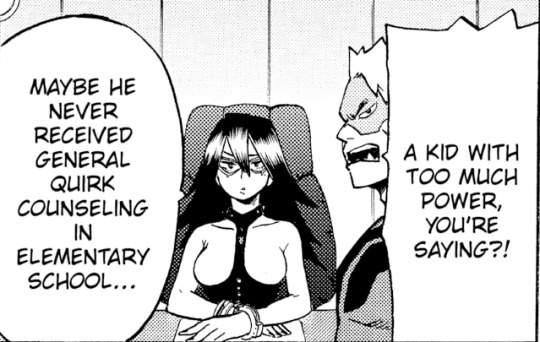
MIDNIGHT ‘Shōgaku-ji no “issei ‘kosei’ COUNSELING” uke tenai no kajira...’ ミッドナイト「小学時の『一斉〝個性〟カウンセリング 』受けてないのかじら...」 Midnight “Didn’t he receive “universal/mass/simultaneous ‘Quirk’ counseling” in elementary school?” [Chap. 22- Ep. 14]
From what Midnight says we can infer that ‘Issei “kosei” COUNSELING’ [一斉〝個性〟カウンセリング “universal/simultaneous/mass ‘Quirk’ counseling”] is given in elementary school as kind of a group activity or class lesson as ‘issei’ (一斉) generally is used to say “simultaneous”, “all at once”, which should imply all the kids at elementary school (or more likely, all the kids in a class) get it at the same time.
For contest, Midnight brings this up because they think Tomura has too much power and was never taught to ‘control’ it (as in not to use it to do what he wants). So we can guess Quirk counseling would, in their mind, have given Tomura a better grasp of what was allowed to do with his Quirk and what wasn’t (with becoming a Villain being definitely on the ‘Don’t do it’ list).
The discussion about Quirk counseling won’t progress any further.
The next time Quirk counseling is mentioned is in chap. 165.
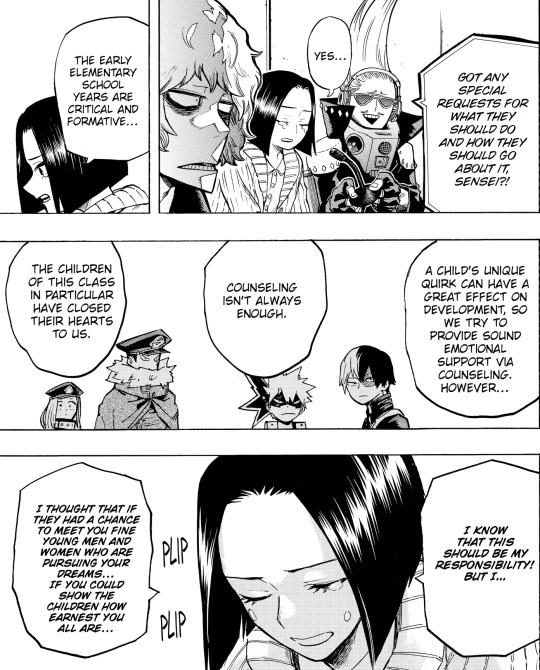
Ikoma Komari ‘Hai… shōgakkō teigakunen wa jinkaku keisei ni oite taisetsuna jiki desu...〝Kosei〟 no chigai ga ōkiku eikyō suru tame COUNSELING o okonai. Sukoyakana seishin o hagukumeru yō SUPPORT suru no desu ga... COUNSELING mo bannōde wa arimasen. Kono CLASS no ko-tachi wa watashi-tachi ni kokoro o tozashite shimaimashita. Watashi no sekinindearu koto wa shōchi shite imasu...! Desuga...! Yume ni mukatte hagende rassharu minasama to fureau koto de massuguna kimochi o omoidasa sete age rarereba…’ 生駒小麿里「はい…小学校低学年は人格形成に於いて大切な時期です...〝個性〟の違いが大きく影響する為カウンセリングを行い。健やかな精神を育めるようサポートするのですが...カウンセリングも万能ではありません。このクラスの子たちは私達に心を閉ざしてしまいました。私の責任であることは承知しています...!ですが...!夢に向かって励んでらっしゃる皆さまと触れ合うことでまっすぐな気持ちを思い出させてあげられれば…」 Ikoma Komari “Yes... the early years of elementary school are an important time for personality development... differences in “Quirk” have a big impact, so we provide counseling. We support them in developing a healthy mind... but counseling is not a panacea. The children in this class have closed their hearts off to us. I know that it is my fault...! But...! I hope that by interacting with all of you who are working hard towards your dreams, we can help them remember their honest feelings...” [Chap. 165-Ep. 79]
Here we don’t talk specifically of Quirk counseling, just of counseling and of how ‘differences in Quirk’ have a big impact on personality development, also adding that counseling is not a fix-it-all. Ironically though, all the kids in the class seems to be the same according to their teachers, ‘mondaiji’ (問題児 “problem children”) who’re always ‘hanko-teki’ (反抗的 “rebellious”/“defiant”) no matter what she does despite them all having very different Quirks, children who have ‘closed their heart’ to them (aka they aren’t listening to them anymore) and feel they’re better than anyone else and it’s clear with this class counseling didn’t work at all.
We jump at chap. 226.
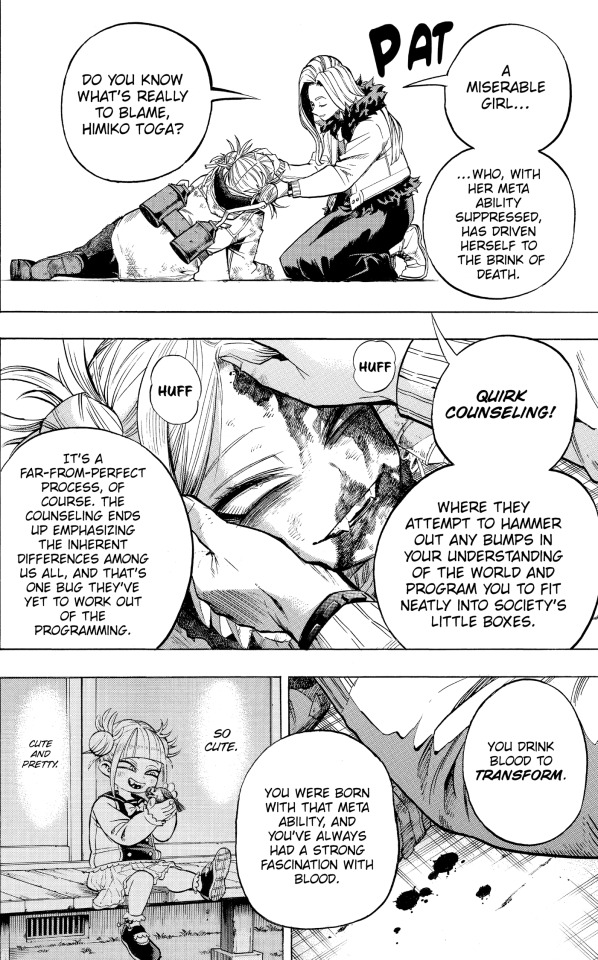
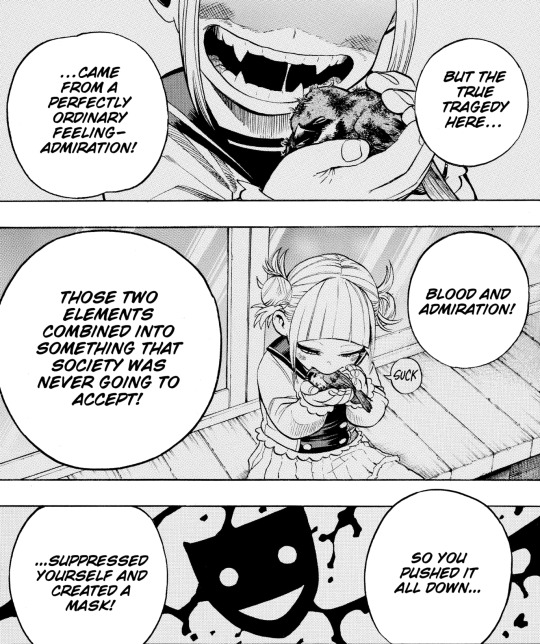
CURIOUS ‘Inō no yokuatsu ni yotte jibun o koroshita fukōna shōjo, sore ga anata nandesho? Toga Himiko. ‘“Kosei” COUNSELING’, jita rikai no yugami o kyōseishi shakaisei no suri awase o hodokosu jōsō kyōiku (read: PROGRAM). Mochiron, kanpekina PROGRAM de wa naishi, kojinsa o yori tsuyoku kanjite shimau to iu mondai o kakaete imasu. Chi o nomi henshin suru, umaretsuki motsu sono inō ni yotte anata wa “chi” ni tsuyoi kyōmi o hikareru yō ni natta. Shikashi shin no fukō wa “akogare” to iu dareshimo ga daku futsū no kanjō. Chi to akogare kamiatte shimatta nitsu no yōso wa tōtei shakai ni ukeire rareru MONO de wa nakatta. Dakara, anata wa FUTA o shita. Jishin o yokuatsu shi kamen o tsukutta.’ キュリオス「異能の抑圧によって自分を殺した不幸な少女、それがあなたなんでしょ?渡我被身子(トガヒミコ)。『〝個性〟カウンセリング』、自他理解の歪みを矯正し社会性の擦り合わせを施す情操教育(プログラム)。もちろん、完璧なプログラムでは無いし、個人差をより強く感じてしまうという問題を抱えています。血を飲み変身する、生まれつき持つその異能によってあなたは〝血〟に強い興味を引かれるようになった。しかし真の不幸は〝憧れ〟という誰しもが抱く普通の感情。血と憧れ噛み合ってしまった2つの要素は到底社会に受け入れられるモノではなかった。だから、あなたはフタをした。自信を抑圧し仮面を作った。」 Curious “You’re an unfortunate girl who killed herself by suppressing her supernatural powers, aren’t you? Toga Himiko. ‘“Quirk” counseling’, it’s an emotional education (read: program) to correct distortions in self-understanding and other things, and to adjust for socialization. Of course, it’s not a perfect program, and it has the problem of making individual differences even more apparent. Your innate ability to transform by drinking blood has made you very interested in “blood”. However, your true misfortune is “admiration”, a normal emotion that anyone can have. The two elements that go together, blood and admiration, were never going to be accepted by society. So you put a lid on it. You suppressed your confidence and made a mask.” [Chap. 226]
Episode 109 should be the one in charge to transpose this scene in animation but episode 109 cut the references to Quirk counseling.
CURIOUS ‘Inō no yokuatsu ni yotte jibun o koroshita fukōna shōjo. Sore ga anata nandesho? Toga Himiko. Umaretsuki motsu sono inō ni yotte anata wa chi ni tsuyoi kyōmi o hikareru yō ni natta. Shikashi, shin no fukō wa akogare to iu dareshimo ga daku futsū no kanjō to chi e no kyōmi, kono futatsu ga kamiatte shimatta koto. Sore wa tōtei shakai ni ukeire rareru MONO de wa nakatta. Dakara, anata wa FUTA o shita. Jishin o yokuatsu shi kamen o tsukutta.’キュリオス「異能の抑圧によって自分を殺した不幸な少女。それがあなたなんでしょ?渡我被身子。生まれつき持つその異能によってあなたは血に強い興味を引かれるようになった。しかし、真の不幸は憧れという誰しもが抱く普通の感情と血への興味、この二つが噛み合ってしまったこと。それは到底社会に受け入れられるモノではなかった。だから、あなたはフタをした。自信を抑圧し仮面を作った。」 Curious “You're the unfortunate girl who killed yourself by suppressing your supernatural powers. That's you, isn't it? Toga Himiko. The supernatural power you were born with has made you very interested in blood. However, your true misfortune was that your fascination with blood and your normal emotion of longing were intertwined. This is something that could never be accepted by society. So you put a lid on it. You suppressed your confidence and made a mask.” [Ep 109]
It’s a bad decision as Quirk counseling was meant to become important later but that’s what they decided to do.
Anyway in the manga there’s something we can work with, if before we were told Quirk counseling helps in developing personality, here it’s clarified the help is aimed at helping people to act ‘normal’, so that they can have a correct perception of themselves as well as socialize and interact correctly, the problem is it suppresses whatever is judged ‘not normal’ in a person and Quirks often generate wild differences between what’s normal for a person and what’s normal for another.
The result of this is that Quirk counseling ends up remarking in an even stronger way the differences between people, by forcing them to suppress feelings that are dictated by their Quirk.
We then jump to chap. 370.
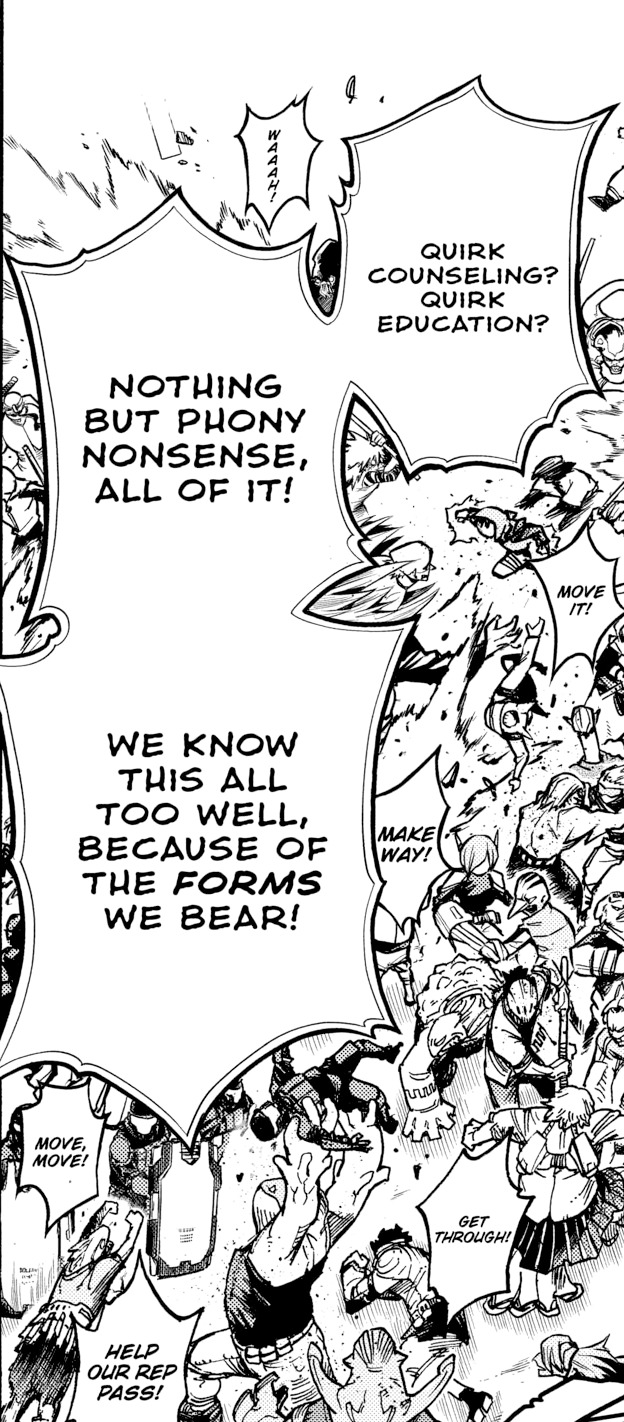
? ‘“Kosei” COUNSELING!” Kosei” kyōiku! Kore ga nise (read: mayakashi) de aru koto o! Wareware wa “katachi” o motte shitte iru!.’ ?「〝個性〟カウンセリング!〝個性〟教育!これが贋(まやかし)である事を!我々は〝形〟を持って知っている!」 ? ““Quirk” counseling! “Quirk” education! This is phony/bogus/sham (read: fake/deception)! We know it due to having this “shape/form”!” [Chap. 370-Ep. 152]
At this point we’ve a nameless heteromorph guy claiming Quirk counseling (along with Quirk education) is basically a sham, it’s not it didn’t work with that class of kids by coincidence, it’s just something that doesn’t really work with Heteromorphs.
While there’s not really an explanation we can guess that, if the point of Quirk counseling is making people ‘normal’, Heteromorphs, who in Japanese are called ‘Igyō’ (異形 “abnormal”), have a hard time with it, since they’re not normal by definition and can’t really change/suppress their ‘not normal’/‘heteromorphic’ traits.
We aren’t told what Heteromorphs are told during Quirk counseling, and the thing is made more complex by how somehow in big cities there’s no discrimination, while in rural villages people still go for ‘chiharai’ (血祓い “blood cleansing”), beating and scarring Heteromorphs who dare to come into contact with not-Heteromorphs, no matter if it’s to save them.
We then jump to chap. 392.
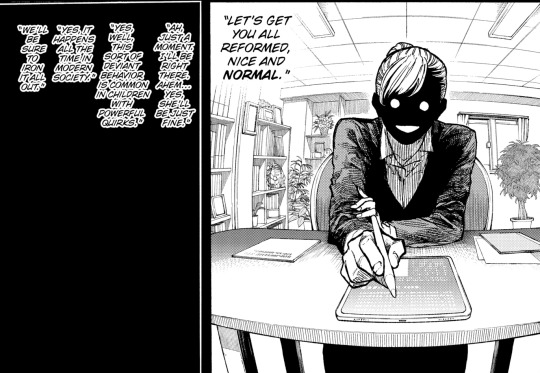
? ‘HAI kyōsei shite ikimashou “futsū” ni. A HAI mō chotto matte kudasai. Sugu sotchi ikimasu. Etto… ē daijōbudesu. Sō desu ne… tsuyoi “kosei” o motsu ko niarigachi na tōsaku desu yo. Kono shakai de wa yoku aru koto desu. Tadashite keshite ikimashou.’ ?「ハイ矯正していきましょう〝普通〟に。あハイもうちょっと待ってください。すぐそっち行きます。えっと…ええ大丈夫です。そうですね…強い〝個性〟を持つ子にありがちな倒錯ですよ。この社会ではよくあることです。正して消していきましょう。」 ? “Yes, let’s correct it and make it “normal”. Ah, yes, please wait a moment. I’ll be there right away. Um... yes, it’s okay. Well... it’s a common perversion among children with strong “Quirks”. It’s common in this society. Let’s correct it and eliminate it.” [Chap. 392]
Here we see a person talking with Himiko’s parents. We aren’t told this person is a Quirk counselor but, I guess, that’s the idea. It’s hard to say if she’s Himiko’s teacher or an external figure, however it makes clear Quirk counseling is more or less what Curious said. That person thought Himiko being fascinated by blood was wrong, she actually calls it a ‘tōsaku’ (倒錯 “perversion”), albeit one she labels as common, and tried to force Himiko to suppress her feelings so she could perceive herself and socialize with the others in a ‘correct’ way.
An interesting difference between the manga and the anime is that in the anime that person’s talk is more streamlined... and we see her also talking with Himiko's parents.


? ‘Hai kyōsei shite ikimashou futsū ni. Sō desu ne… tsuyoi kosei o motsu ko niari-gachina tōsakudesu yo. Kono shakaide wa yoku aru kotodesu. Sei shite keshite ikimashou.’ ?「ハイ矯正していきましょう普通に。そうですね…強い個性を持つ子にありがちな倒錯ですよ。この社会ではよくあることです。正して消していきましょう。」 ? “Yes, let's correct it and make it normal. It's a perversion that is common among children with strong Quirks. It's a common occurrence in this society. Let's correct it and eliminate it.” [Ep. 158]
This might imply that in the manga that person is actually busy with more things at once, she doesn’t have a lot of time to dedicate to Himiko’s parents and therefore she doesn’t have a lot of time to dedicate to Himiko.
Back to the conversation though, regardless of the source, the person talking makes clear that what Himiko does isn’t just something that’s “rude”/“inappropriate” to do in society but that it’s a “perversion”, a common one, yes, but a “perversion” and she says so to her parents who were already worried she wasn’t human.

Chichioya ‘Mō nekko ga!’ 父親「もう根っこが!」 Father “Her core/roots is/are already– (gone/rotten)!”
Hahaoya ‘Ningen ja nai ko un jatta!’ 母親「人間じゃない子産んじゃった!」 Mother “I gave birth to a child that isn’t human!” [Chap. 392-Ep. 158]
And later
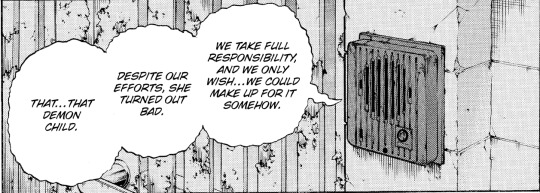
Hahaoya ‘Watashi-tachi ga waruin desu. Mō… tsugunai kirenai desu… ganbatta kedo damedattan desu… ano ko ha… akuma no konan desu.’ 母親「私たちが悪いんです。もう…償い切れないです…頑張ったけど駄目だったんです…あの子は…悪魔の子なんです。」 Mother “It's our fault. We can never make up for it. We tried our best but it was no use. That child is a demon's child.” [Chap. 226]
So Quirk counseling didn’t really reassure her parents nor solved Himiko’s problems. They weren’t going to accept that Himiko could have different feelings from the norm and help her to cope with them correctly, they just wanted to eradicate them from her. As she couldn’t, she was forced to suppress them… and since she couldn’t keep them bottled up forever they eventually exploded and lead her to hurt Saito.
The last time Quirk counseling comes up is at the end of the manga.

? ‘Tsudzuite wa TEAM-UP NEWS. INGENIUM, FROPPY, CREATI soshite URAVITY ga zenkoku no shōgakkō o megutte imasu. Teki (read: VILLAIN) hasseiritsu no genshō ni tomonai katsudō no haba wo hirogeru “HERO”-tachi sono naka demo-- URAVITY no uchidashita “kosei” COUNSELING kakuchō keikaku wa ima mottomo hitsuyō fukaketsuna katsudō to iwa rete imasu.’ ?「続いてはチームアップニュース。インゲニウムフロッピー・クリエティそしてウラビティが全国の小学校を巡っています。敵(ヴィラン)発生率の減少に伴い活動の幅を広げる〝ヒーロー〟たちその中でもーーウラビティの打ち出した〝個性〟カウンセリング拡張計画は今最も必要不可欠な活動と言われています。」 ? “Next up is team-up news. Ingenium, Froppy, Creativity and Uravity are touring elementary schools across the country. As enemy (read: Villain) occurrence rates decrease, the “heroes” are expanding the scope of their activities. Among them, Uravity’s “Quirk” counseling expansion plan is said to be the most essential activity right now.” [Chap. 430]
In this bit it seems that expanding Quirk counseling became a key factor in lowering the occurrence rate of Villains… which, of course, doesn’t seem to be possible since in almost all the other cases in which Quirk counseling was mentioned it turned out it either didn’t work (with the Masegaki elementary school kids) or made matters worse (Himiko and the heteromorphs). Is it a typing mistake as apparently the program already reached all the elementary schools so it didn’t need to be expanded and, anyway, didn’t work? Or does ‘expanding’ refers to actually put more resources and people in Quirk counseling so they can actually devote more time to the kids and help them better? Hard to say.
LOOKING AT THE CULTURAL CONTEST AND WHAT IT TELLS US
Counseling in Japan
While, of course, there’s no Quirk counseling in Japan, by 2006 Japan had school counselors (スクールカウンセラー) available in all the public middle schools. Prior to it though, this work was entrusted to the homeroom teacher (担任教師 ‘Tannin kyōshi’) and often also the school nurse (看護教諭 ‘Kango kyōyu’ ) who were meant to dispense discipline, encourage better conduct, increase motivation, provide career guidance, and offer advice. Those teachers though, were not trained in counseling, and it was often a duty they disliked, often choosing to use their classroom hours for something different than “moral education” depending on their personal educational agenda. Now instead, when problems arise, the teacher or the students or the students’ parents can ask help to the school counselor, which would also offer the plus of being a third party figure, so that they would be people not involved in evaluating students (and therefore have no conflict of interests with them) and would be professional in the field of psychology so as to offer better help to them.
Currently in Japan a school counselor visits a school about once a week to give children advice about various problems they face. School counseling is provided by clinical psychologists, psychiatrists and other professionals with expertise in mental health issues. In addition to advising children, the counselors can advise parents and teachers about how to handle their own day-to-day. A school counselor stands by in a counseling room where he or she listens to children’s problems one-on-one. Children can seek advice about whatever may worry them, such as relations with their friends, their family problems and uncertainties about their future and the counselor will advice them about how they should handle their problems while also talking with their homeroom teachers about what would be the best solution to each problem.
The problems with this system are often that the Clinical Psychologist isn’t also trained as a school counselor which leads with problems of interaction with the teachers, that there is confusion about the role of teachers and school counselors, and that there’s a HUGE stigma of shame at the idea of students or parents seeing a counselor. Much of the counseling that is now conducted in the Japanese schools is remedial with the individual as the focus; an approach that is contrary to the Asian interdependent view of self, an approach that seems to further exacerbate the student’s reluctance to see the school counselor.
It’s possible that Horikoshi, for earlier Quirk counseling, went with mix of the above, with it given both by the class homeroom teacher and by a specialist, or it given by the homeroom teacher only. It's not really clear.
Honne, Tatemae and Giri
Honne (本音 “true sound”) refers to a person's true feelings and desires.
Tatemae (建前 “built in front”, “façade”) refers contrastingly to the behavior and opinions one displays in public.
Giri (義理 “duty”, “obligation”) refers to the social obligations each person have.
Okay, fine, why should we care about these three words? Because Japanese people go to great length to hide their honne (true feelings) and show their tatemae (facade) so as to fulfill their giri (social obligation). They must do everything they can to avoid the disapproval of others, to avoid direct confrontation or disagreement. They’re completely justified in telling white lies to hide their true nature and present their Tatemae, so completely justified they can lie even in trial, that they’re expected to do so (remember when, in chap. 306, a guy said Enji should have just lied in regard to what Touya declared?).
Part of the Quirk counseling plan is clearly based on this, on teaching children how to show a socially acceptable tatemae and hide their own honne. This is what Himiko was taught, that her own fascination for blood was an unacceptable honne and needed to be buried inside herself if she wanted to be ‘normal’. That it was her duty to present herself as ‘normal’ and therefore show solely an acceptable tatemae.
Tōsaku (倒錯 “perversion”) and double meanings
As said before ‘Tōsaku’ means “perversion” and it’s used to describe how Himiko is fascinated by blood… but this is a word also used to describe sexual deviances… and Horikoshi clearly had fun with using words with double meanings in Himiko’s case, for example the onomatopoeia for sucking blood (ちうちう ‘chiuchiu’), sounds also like the onomatopoeia for kissing, Himiko is referred as a ‘ijōsha’ (異常者) which can be translated as “deviant” but also as “pervert” and so on. In short Horikoshi subtly create parallels between Himiko’s love for blood and the fact that Himiko’s way of loving people is not what in Japan is labeled as normal (she also loves girls and not just boys and would like to hurt people she loves). So, while Himiko’s problem of being fascinated with blood might seem distant from the audience as people in real world don’t have a Quirk that makes them fascinated with blood, the parallelism with sexual inclinations bring Himiko back into someone with whom people can relate and, in a way, someone that stands in parallel with Magne.
Heteromorphs, how ‘not normal’ they are meant to be and blood impurity
In English the word ‘Igyō’ (異形) had been translated as “heteromorph” but a better translation is “abnormal” or, more literally “not normal shape”. In a Quirk counseling program that aims at making everyone ‘normal’, who already starts with a name that states they’re not with a normal shape is clearly cut out of the race.
When Shouji talks of what was done to him he mentions ‘chiharai’ (血祓い “blood cleansing”) [Chap. 371] and, in the previous chapter, he was told he had ‘imi chi’ (忌み血 “cursed blood”) [Chap. 370].
Japan is very invested in blood purity, in pre-Meiji era Shinto and Buddhist traditions considered blood (血 ‘chi’) a source of symbolic pollution or ‘kegare’ (穢れ “uncleanness”, “defilement”) with elaborate rituals of avoidance and purification, however, in the Edo period (1603–1868) blood gained the positive meaning of “lineage”/”life force”, overtaking the preceding key metaphors for heredity. This though ended up causing the solidification of a hereditary status system that placed certain groups of people as being permanently “polluted” because they had works tied with blood, like executioners, undertakers, slaughterhouse workers, butchers, and tanners called ‘eta’ (穢多 “great filth”) as well as beggars, street performers, prostitutes, convicted criminals, and the physically disabled among others called ‘hinin’ (非人 “not people”) which together form the group called ‘burakumin’ (部落民 “village people”) and were considered outcasts. Their own blood was considered permanently impure, they were subject to increasingly stricter sanctions that prohibited their contact and mixing with the rest of society by means of restricted residences, economic activities, special clothing, hairstyles, and tattoos and since now blood also was a term used to define lineage, its polluting property also came to be regarded as inheritable and permanent which is why people still don’t want to marry (aka ‘mix blood’) with people whose ancestors were ‘burakumin’.
This was also made worse from the 1900 eugenicist obsession with blood as a medium to modernize the Japanese race and nation.The pure Japanese blood, or “Yamato blood,” was now heralded as a refined superior substance to be protected or enhanced through social programs of reproduction and health also through eugenic marriage counseling services.
This ultimately expanded to include people who had mental illness or familiar with mental illness but also with people who are of not pure Japanese ancestry. We would probably talk about genetics. In Japan it’s referred as blood.
Blood type is, in Japanese mentality, also tied with personality and discrimination can be so high that some would just discriminate people with blood type B or AB as negative stereotyping credits the B types as selfish, and ABs as eccentric and unpredictable and therefore more prone to have a loose morality.
As a result even if Shouji being a Heteromorph is tied to his Quirk and his genes, the story talks about his ‘cursed blood’… and people could refer to it also in relation to how the Todoroki are related to a criminal, Touya/Dabi.
(Plus this also tells you why Himiko's fascination for blood could NEVER be accepted since things related to blood lead to impurity)
While all this doesn’t tell us much about Quirk counseling, it helps to get a better perspective on why blood is mentioned when Heteromorphs are discriminated and how strong discrimination can be based to blood ties, clearly making it something that can’t be overcome with just the discriminated person in question trying to ‘act normal’ by presenting an acceptable ‘tatemae’.
The series leaves unclear what exactly falls into the Heteromorph category because, if the problem is just the shape being not normal, things like having tapes in your arms or engines in your legs, or horns on your head also give you an abnormal shape. Overall we can assume that the more the shape is abnormal and hard to ‘disguise’ as normal, the more one ends up being considered as an Heteromorph (Shouji’s arms are a much more visible ‘abnormal’ trait than Iida’s legs or Sero’s arms).
Just so you know currently Japan lacks any law which prohibits racial, ethnic, or religious discrimination nor has any national human rights institutions. Although racism exists it’s a taboo topic. In the past in the name of national unity, the Japanese government identified and forcefully assimilated marginalized populations, which included indigenous Ryukyuans, Ainu, and other underrepresented groups, imposing assimilation programs in language, culture and religion. Japan considers these ethnic groups as a mere “subgroup” of the Japanese people and therefore synonymous to the Yamato people, and does not recognize them as a minority group with a distinct culture. This is why in the story Heteromorph discrimination isn’t punished but it could also be the basis for why the Quirk counseling doesn’t keep into consideration how Heteromorphs are different but tries to force them too to act ‘normal’.
Quirk
We’re all familiar with the term Quirk that in Japanese is ‘kosei’ (〝個性〟 always written between quotation marks) which, translated literally means “individuality” or “personality”. In a country that is group oriented, values uniformity and thinks standing out is bad, Quirks that instead grant an even more marked ‘individuality’ and that are unique to each person, should feel like a big deal… but also it you tie a superpower with your personality you might get some unpleasant combo that aren’t really meant to be. For example thinks at Tomura and at how his Quirk destroy/decay things. If you think that his Quirk is his ‘personality’ or tied to it, you get the idea Tomura is someone who can only destroy/decay, that has a destructive character, or that who has an animal Quirk has an animal character.
WHERE ALL THIS LEAVES US?
Japanese youths have been fighting so as to have their individuality recognized in various subtle ways but it’s still an ongoing battle. The same goes for the descendant of the Burakumin and for people in the LGBTQ+ community. Sadly most of those topics are kind of considered taboo to discuss in Japanese culture so it’s possible that Horikoshi’s attempt at saying that Quirk counseling would be improved is a subtle message that’s meant to say that in the BNHA world steps would be taken to improve the acceptance of those people and the recognition of each person’s individuality, implying more a change into mentality/education than a change into some institutionalized thing called ‘Quirk counseling’, hence he didn’t need to develop much how it would work.
Of course mine is purely speculation.
Ultimately, if we solely look at the story, how Quirk counseling work/is administered is hardly well explained in the story, and how is reformed is explained even less (saying just it underwent an expansion) as well as why Uraraka, who had no idea of Himiko’s problems with Quirk counseling, decided to focus on it. But it’s likely the cultural context that’s meant to make it work for Japanese readers using solely what little is explained as reference and, for them, improving it, is likely a big step.
For whose of us who are instead cut out from the whole cultural context, there’s just too little to work with and it feels forgettable and confusing.
Okay, my analysis originally was meant to end here but then chapter 431 was released and it talked about Quirk counseling and so I added this extra bit.
CHAPTER 431 AND WHAT IT TELLS TO US
In the volume version only chapter 431 we have a last mention of Quirk counseling, which ‘shows us’ a bit how it’s done now.





Uraraka Ochako ‘Masaka senpai-tachi no tsugō ga tsuku to wa‼ Kitto minna yorokobimasu!’ 麗日お茶子「まさか先輩たちの都合がつくとは‼きっと皆喜びます!」 Uraraka Ochako “I never thought my seniors would be able to make it! I'm sure everyone will be happy!”
Tōgata Mirio ‘Ore nankade ī no kana‼’ 通形ミリオ「俺なんかでいいのかな‼」 Tōgata Mirio “I wonder if I am the right person for this?”
Hadō Nejire ‘Nande sonna koto iu no? Fushigi!’ 波動ねじれ「なんでそんな事言うの?ふしぎ!」 Hadō Nejire “Why would you say that? Strange!”
Amajiki Tamaki ‘URAVITY no “kosei” COUNSELING ni kyōryoku dekiru nante kōei da yo.’ 天喰環「ウラビティの"個性"カウンセリングに協力できるなんて光栄だよ。」 Amajiki Tamaki “It's an honor to help Uravity’s ‘quirk’ counseling.”
Uraraka Ochako ‘Kono gakku no jidō no shiryō-me o tōshite moratta to omoundesu kedo nani yori daiji na no wa COMUNICATION desu. Ikken nan no mondai mo nai ko demo nayami o shimaikonderu koto ga ōi desu. Daishō towazu toku ni katei kankyō nanka shotaimen no otona ni hanaseru hito wa ōkunai desu. Demo jikan o kakereba kanarazu SAIN o dashiteru koto ni kidzukeru node shiryō ni tayori sugizu! Meyasu wa ikkagetsu teido desu ga naiyō shidai de zenzen hendō shimasu. Kazu wa ishiki shinaide otomodachi ni naru tsumori de!’ 麗日お茶子「この学区の児童の資料目を通してもらったと思うんですけど何より大事なのはコミュニケーションです。一見何の問題もない子でも悩みをしまい込んでる事が多いです。大小問わず特に家庭環境なんか初対面の大人に話せる人は多くないです。でも時間をかければ必ずサインを出してる事に気付けるので資料に頼りすぎず!目安は一か月程度ですが内容次第で全然変動します。数は意識しないでお友だちになるつもりで!」 Uraraka Ochako “I think you've looked through the materials about the children in this school district, but the most important thing is communication. Even children who appear to have no problems often keep their worries to themselves. Not many people, can talk to adults they meet for the first time, about problems big or small, especially about their home environment. But if you take your time, you'll definitely notice the signs, so don't rely too much on the materials! The guideline is about a month, but it can vary greatly depending on the content. Don't worry about numbers, just try to make friends!”
Amajiki Tamaki ‘Taihen da ne.’ 天喰環「大変だね。」 Amajiki Tamaki “That's tough.”
Uraraka Ochako ‘Zenzen! Jin'in no SUPPORT wa jūbun desu shi minasan sugoku teinei na oshigoto o sarerun desu yo. HAWKS ga monkashō ni kake attari kakusho ni kyōsan o tsumettari shite kurete “kosei” kyōiku no kankyō wa daibu kaizen sarete kiterundesu.’ 麗日お茶子「全然!人員のサポートは十分ですし皆さんすごく丁寧なお仕事をされるんですよ。ホークスが文科省に掛け合ったり各所に協賛を積めったりしてくれて"個性"教育の環境はだいぶ改善されてきてるんです。」 Uraraka Ochako “Not at all! There is enough staff of support and everyone does a very careful job. Hawks has been negotiating with the Ministry of Education and providing support from various places, and the environment for ‘Quirk’ education has improved considerably.”
Amajiki Tamaki ‘Jā ima wa jibun no tame no jikan mo torerunda?’ 天喰環「じゃあ今は自分の為の時間も取れるんだ?」 Amajiki Tamaki “So now you have time for yourself?”
Uraraka Ochako ‘Gimu toka… sekinin toka nai wake ja nai desu kedo ato kara tsuitekita mono desu. Yorokobu kao o miru no ga suki nandesu. Watashi ga yaritaikoto shitemasu. Tsuyu-chan mo hobo zutto TEAM-UP shite kureteru shi tomodachi to mo aeteru shi zenbu jibun no tame no jikan desu yo!’ 麗日お茶子「義務とか…責任とかないわけじゃないですけど後からついてきたものです。喜ぶ顔を見るのが好きなんです。私がやりたい事してます。梅雨ちゃんもほぼずっとチームアップしてくれてるし友だちとも会えてるし全部 自分の為の時間ですよ!」 Uraraka Ochako “It's not that I don't have obligations or responsibilities, but they came after. I like to see people's happy faces. I'm doing what I want to do. Tsuyu-chan has been teaming up with me almost all the time, I've been able to meet up with my friends, and so it's all time just for myself!” [Chap. 431] Now, I’m not 100% sure if the idea is to always involve Pro Heroes or ‘the supporting staff’ can be composed also of ‘not Pro Hero’ people, but we get a general idea of what the people who decide to take part to the project should do. They read the documents about the kids, they’re encouraged to make friends with them, possibly/likely involving them in a game in which they use their Quirk which will allow them to receive what we can call ‘Quirk positivity’. All this in order to help children to open up and talk about their (Quirk related) problems. This last for around a month then, if no problems are detected (or if they are but they’re solved by that time), the people involved move to another school.
Now… maybe it’s just me but this is basically what was done during the ‘remedial course’ arc with the kids from the Masegaki school, only, they’re given documentation about the kids and, instead than lasting one time, it last one month and it involves Pro Heroes, not Heroes in training who might not be interested in interacting with children but are forced to do it if they want their license.
In this sense the whole ‘expansion’ thing of chapter 430 finds it’s explanation. Heroes are expanding their activities (aka also taking part to other activities like Uraraka’s Quirk counseling program) and the Quirk counseling program is being expanded as well as now its scope isn’t anymore to just help children to fit into the standards of normalcy society created but to offer them Quirk positivity and to create a connection so that THE CHILDREN will be willing to talk about their problems with Quirk and with their family.
Storywise it’s a pity the original characters involved in the ‘remedial course’ arc aren’t mentioned as being involved in all this, especially Shouto (who not only had an extremely troublesome Quirk related family situation plus a brother with problems with his Quirk who almost killed himself, was targeted by a Villain, became a Villain and eventually died). Yes, we can picture they are, but, as far as canon is concerned, he isn’t mentioned AT ALL, not even as one of the sources of inspiration for how Uraraka’s project is structured (canon also didn’t show Bakugou or Shouto talking about their remedial course with classmates) but okay, this isn’t really related to Quirk counseling.
Now with all those additional info I can talk a bit of something else aka:
REALITY CHECK
Uraraka’s project is nice and well meaning but it’s also very fairytalesque, in the same way as Hawks claiming that Heroes having free time would be a good thing. It’s all well and good and, since BNHA is a tale, I’m sure it’ll work like a charm and if you want to stop reading here and enjoy such a happy world I’ll understand you.
However if you want to know if this will work in the real world…
In the real world, if the request for Heroes were to decrease because there are less Villains (and having less Villains would surely be a good thing), it wouldn’t mean people would hire the same amount of Heroes and keep on paying them just the same, we would simply have more unemployed Heroes or society would self regulate itself by simply giving out less and less Hero licenses. In short, society would NEVER allow Heroes to have more free time, it would just hire less Heroes or, in the very best case, pay them less. Sure, the problem can be solved with Heroes reinventing their job, for example volunteering to take part to Uraraka’s Quirk counseling project so as not to lose their job and their source of income.
With this though, comes a worsening of the main problem I see in Uraraka’s Quirk counseling project.
There is no mention whatsoever that the people involved are TRAINED to spot (Quirk related) psychological problems. Kids with psychological problems (due to their Quirk and family environment reacting badly to their Quirk) aren’t necessarily always showing a villainous behavior or a transgressive behavior (which is what Heroes are trained to spot), they can be acting as ordinary well behaving kids, or be meek or be people pleasers or vivacious but apparently harmless kids.
While it’s true that elementary school kids are generally more direct in their actions and reactions, some of them could have already mastered the fine art of hiding/masking things for fear of repercussions or due to them being educated to lie about certain things or even being made believe in such lies so they don’t even know they’re lying anymore.
Quirks, it’s worth to mention, don’t necessarily manifest at 4, they can manifest as early as their childbirth (see the luminescent baby or AFO himself), and sometimes a child can be born in a house where the ‘Quirk problems’ are caused by the parents’ expectations (think at how Enji wanted his children to have a certain Quirk and inherit his place). In short they might have been forced BY BIRTH to interact with ‘unpleasant’ situations and might have also been forced to learn to cover them up.
Fuyumi for example, lived in a toxic environment but, likely, masked that up well. Himiko took longer at learning to mask it up well, but her Quirk manifested when she was areound 3 or 4 and gave her a really strong instinct, for which she was left with zero family support (actually her parents’ reaction is completely out of proportion, kids at that age do plenty of stupid and gross things and then can grow up perfectly normal provided they’ve normal parents to guide them, there was totally no need to beat Himiko up and panic like that) and yet she learnt to mask it perfectly by the time she was in middle school, possibly even sooner as the journalists couldn’t find early signs and they likely searched for them like starved piranha.
In truth even professionals might miss the signs or might approach children in the wrong manner, causing more troubles than good because it’s a HARD job… so the idea that if completely untrained adult people who just read some data about the children (which might have been written by who already missed the signs or is misinformed about the real situation of the children) were to make friends with them, they would surely get them to open up or would surely notice signs that something is wrong and act in the appropriate manner to fix it is… well… very naïve.
It’s well meaning and it can surely help in some cases but, unless Japan had a REALLY ABNORMAL PROBLEM so that the TINIEST help would make a BIG difference, don’t expect the big change the press is talking about… especially if Heroes who have no more Villains to capture and zero interest in helping kids will be ‘forced’ to join the program so as not to become unemployed.
On the other side the lack of psychological preparation in people can be very well explained with how there’s a strong stigma in Japan regarding psychological problems.
The reason why real life normal counseling is often not used in Japan is because Japanese people don’t want to talk with a Clinical Psychologist (as said before now that’s the specialization a counselor needs to have) so Horikoshi’s ‘hey, but those people are normal, well meaning people, possibly even Heroes kids admire, not psychologists so talking to them doesn’t mean you’ve psychological problems so you can totally open up with them safely’ is meant to address this fear and, of course, it’s better to talk to an untrained person than not to talk at all so in this vein, this could be seen as an ‘improvement’.
I don’t know but I guess this is now really all we have about Quirk counseling.
Said all this, which is likely still an incomplete overview, I hope my ramblings will help people to understand Quirk counseling better. If not, I apologize.
#boku no hero academia#bnha meta#mha meta#bnha spoilers#Toga Himiko#bnha observations#bnha ramblings#Uraraka Ochako#Kayama Nemuri#Ikoma Komari#Kizuki Chitose#Iguchi Shuuichi#Shouji Mezou#Shigaraki Tomura
106 notes
·
View notes
Text
なぜ人は共産主義に騙され続けるのか
2019年08月20日 23時00分
なぜ人は共産主義に騙され続けるのか。私が共産主義の失敗を予見したのは小学2年生のときである。担任の先生が産休に入り、自習の時間が多くあった。私は与えられた課題に黙々と取り組んでいたが、普通の小学2年生が自習を課せられて、黙って勉強するはずがない。周りの生徒はみんな大騒ぎだったので、隣のクラスの先生が注意に来た。結局、私を含めクラスの生徒全員が罰を受けることになった。
私はそのとき、共産主義は絶対うまくいかないと確信した。私が小学2年生だった1978年当時、ソ連はまだ大国として健在で、共産主義は素晴らしいと考える人が多くいた。でも、私は彼らを信じなくなった。真面目にやってもやらなくても、みんな同じように怒られるなら、誰も真面目にやらない。結果の平等は絶対うまくいかない。そんな単純なことをなぜ大人は分からないのだろう。とても不思議だった。その11年後ベルリンの壁は崩壊し、さらにその2年後にはソ連も崩壊した。
ソ連が崩壊して以降も、数は少なくなったが共産主義を信奉し続ける人は存在し続けた。それがまた不思議だった。左翼はウソつきなのか、それとも単に学習能力がないのかという点が当時の関心事だった。正直で頭のいい人は左派にはなれないというレイモン・アロンの言葉を知ったのはその後のことである。
左翼とは何か。人はなぜ左翼になるのか。私にとって常に頭の片隅に存在し続けた謎であった。しかし、私の専門は工学であって人文社会科学ではないため、この問いは仕事として取り組むべきものではなく、ずっと放置したままだった。ところが、幸いにもここ2、3年の間に、その謎がかなり解けてきたのである。
1つのきっかけは、英語圏の政治系YouTuberのウォッチを始めたことである。そこで、欧米でも人々が左翼の横暴に苦しんでいる現状を知ることができた。それを通じて、欧米の左翼と日本の左翼の共通点を見出すことに成功し、左翼というものを一段高い段階に抽象化して理解することが可能となった。
もう1つのきっかけは、インターネット・SNSの隆盛により、大量の言語資源が簡単に取得できるようになったことである。私自身の専門分野の一つに人工知能があるが、インターネット上のビッグデータを機械学習に使えるようになったため、政治問題や社会問題に関する言説を定量的に分析できる時代になった。それにより、自らの理工系の知見を左翼の分析に使えるようになったのである。
今回はそのうち、欧米の左翼運動と日本の左翼運動の共通点から見える左翼像を紹介することにする。左翼運動は、人権、平和、寛容、多様性など常に美辞麗句を看板に掲げる。しかし、その運動の矛先は極めて恣意的に選ばれている。
日本の場合、左翼の人権運動は北朝鮮による拉致被害者の人権を無視する。平和運動も、中国や北朝鮮の核開発や軍拡に抗議をしない。反原発運動も、中国や韓国の原発には反対しない。これらに共通するのは、周辺諸国が日本を侵略しやすい状態を作り出す方向に運動が向いていることである。それゆえ、日本では「左翼=反日」と理解されていることが多い。日本人の目につく左翼運動にかかわる外国人は、みな反日勢力に見えるため、外国の左翼も反日的であるとの誤解を持つ保守系日本人は多い。しかし、それは間違いである���
欧米の左翼にとっての最大の敵はキリスト教的価値観に基づく西洋文明である。であるから、イスラム教などの異文化に対するトレランス(寛容)を主張しつつ、キリスト教的価値観を弾圧する。たとえば、米国の大学では学内のキリスト教徒のサークルを解散させるなどの動きがある。また、欧米のフェミニストは女性の権利を主張する一方で、イスラム系移民の性犯罪の被害を受けた女性に対しては口封じをする。
日本と欧米の左翼に共通する点は、いずれも自らの属する社会や文化を憎み、その破壊を意図していることである。その憎悪の感情は、過大な自己評価ゆえに、周囲が自分を正当に評価していないと不満を持つことから生じている場合が多い。ただし、これは全ての左翼に該当するわけではない。左翼運動は、さまざまな種類の人間の複合体である。
私は、左翼運動の構成員を次の3つに分類している。
1.中核層
自らが属する社会を憎み、それを破壊することを目指す人たち。見せかけの理想を掲げて活動を興し、その活動が社会の破壊に結びつくよう巧みに制御する。良心は無いが知的レベルは高い。
2.利権層
中核層に従うことで、活動資金や仕事(テレビ出演など)を得ることが目的の人たち。
3.浮動層
中核層が掲げた理想に共感する人たち。正義感に基づいて行動するが、いい人と思われたいという虚栄心があることも多い。知識を身に着けると、騙されたと気づいて活動から去る。
初代FBI長官のジョン・エドガー・フーヴァー氏は、左翼(コミンテルン)を
・「公然の(共産)党員」
・「非公然の党員(共産党の極秘活動に従事する人)」
・「フェロー・トラベラーズ(共産党の同伴者)」
・「オポチュニスツ(機会主義者)」
・「デュープス(騙されやすい人)」
の5種類に分類している。(この分類は、江崎道朗氏の著書『コミンテルンの謀略と日本の敗戦』に紹介されている。)このうちの最初の3つが中核層、利権層がオポチュニスツ、浮動層がデュープスに対応する。
正直で頭のいい人は左派にはなれないというレイモン・アロンの言葉に対応させると、中核層と利権層は不正直で頭のいい人であり、浮動層は正直で頭の悪い人である。その複合体が左翼というわけである。
保守派は左翼と違って単純な人が多い。そのため、上で述べた左翼の全貌が見えていない。左翼はみな浮動層であると勘違いして甘く見る。しかし、その認識自体が完全に左翼の術中に嵌っているのである。
左翼運動が巧みなところは、その運動において浮動層を前面に押し出すことである。中核層は基本的に表に出てこない。浮動層は善良な庶民であるから、左翼運動を叩く人は庶民の敵だとレッテルを貼れる。浮動層には悪意がないから、左翼運動の真の目的が破壊であるとの批判は濡れ衣に見える。彼らには知性も感じられないから、取るに足らない相手だと保守派も油断する。
左翼運動の知性の高さは、その攻撃先の選定に見て取ることができる。例えば、日本の自然保護運動を考えよう。彼らは、ダム、堤防、防潮堤、基地建設、高速道路、リニア新幹線、地熱発電のように、日本の安全や経済にプラスになる開発行為の自然破壊は非難するが、太陽光発電、風力発電、中国の珊瑚乱獲のように、日本にとって経済的・社会的マイナスが大きい自然破壊は問題視しない。中でも、発電に関する態度の違いは、それなりに高度な知識がないとこのような見極めはできない。
さらに左翼の頭の良さは、主力は上述のような攻撃先の選択をしつつ、それ以外の勢力はある程度意見を散らしている点にも見ることができる。これにより、批判されたときに傍流の人々を引き合いに出し、批判が不当なものであると反論できるように準備している。
左翼運動は、今後もその頭脳を駆使して庶民の味方を詐称し続けるであろう。現実には、彼らは庶民に選択の自由を与えない。自分の言いなりにならないものは、弱者であっても容赦なく叩きのめす。であるから、左翼はリベラリスト(自由主義者)とは最も遠い存在である。にもかかわらず、彼らはリベラルを自称し、その称号を社会的に広く認めさせることに成功している。
左翼の欺瞞を示す最も有効な手段は、過去の共産主義国家が何をしたかを思い起こさせることである。彼らは、常に庶民(労働者)の味方であると自称したが、過去全ての事例において特権階級が庶民を虐げる社会が生まれる結果となった。おびただしい数の人命も奪われた。その歴史をできるだけ多くの人に直視させることが、共産主義の悲劇を繰り返さないために最も重要なことである。
83 notes
·
View notes



